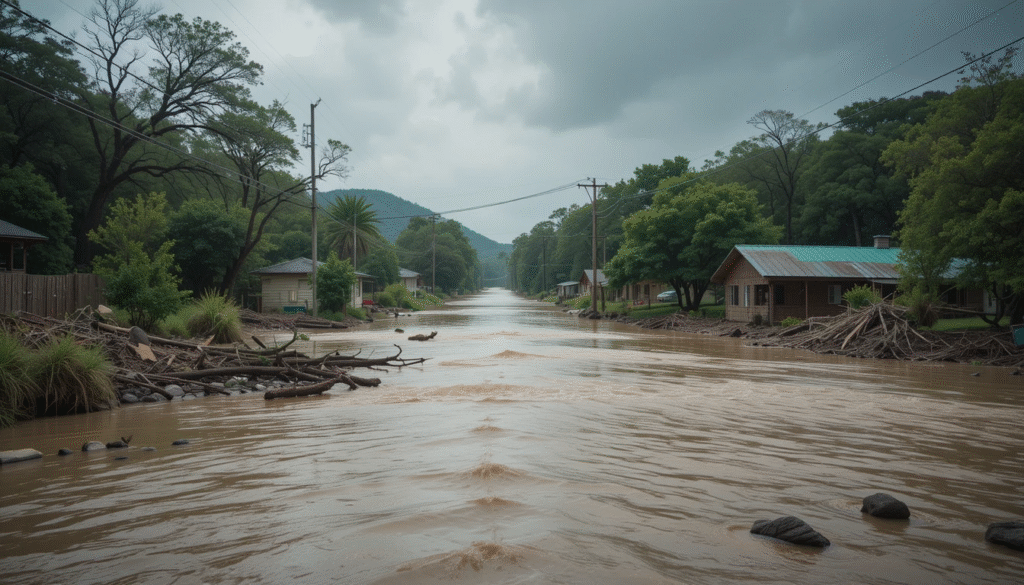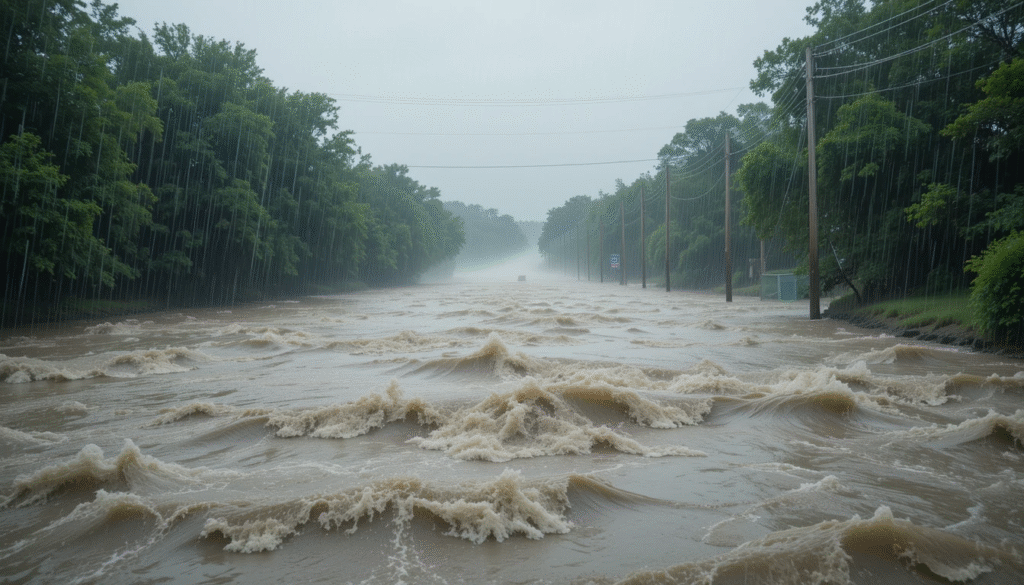
Devastating Floods in Central Texas – In early July 2025, Central Texas was gripped by unprecedented tragedy when record-breaking flash floods swept through the Hill Country, claiming over 135 lives and leaving communities shattered. The catastrophe, driven by a complex weather system, has become the deadliest inland flood in decades and a somber reminder of our infrastructure’s vulnerability to sudden natural disasters
Unfolding of a Sudden Monsoon

Between July 4 and 5, 2025, a dangerous convergence of atmospheric phenomena unleashed torrential downpours across Central Texas. A mesoscale convective vortex, bolstered by tropical remnants of Atlantic’s Tropical Storm Barry and moisture from the eastern Pacific, triggered a massive deluge over the Guadalupe River watershed Wikipedia. Lyon County’s Guadalupe River surged rapidly—reports indicate water levels climbed in less than an hour—while areas like Hunt witnessed more than a year’s worth of rain within a few hours Wikipedia.
Unprecedented Loss of Life
The results were catastrophic. The flood is now recorded as the deadliest inland flooding event in the U.S. since the 1976 Big Thompson River disaster. Over 135 fatalities were officially reported, with Kerr County alone accounting for at least 117 of those deaths Wikipedia. In a haunting turn of events, more than 20 children from a summer camp along the Guadalupe River were reported missing amid the flood’s chaos Wikipedia.
Disruption, Chaos, and Rescue Challenges
Emergency agencies issued six flash flood emergencies, including alerts for Kerrville and Mason. Devastation on the ground was swift: bridges were washed away, roads rendered impassable, and homes submerged or carried off by surging water Wikipedia. Rescue teams—from local authorities to national volunteers—confronted perilous conditions as they worked tirelessly to locate survivors and tend to the injured.
Yet the scale of the disaster posed logistical nightmares. With much of the infrastructure demolished, first responders struggled to reach the hardest-hit zones. Compounding the challenge, Kerr County lacked a dedicated flood warning system—despite earlier local warnings about the area’s flood risk Wikipedia.
Infrastructure Gaps Amplify Toll
This heartbreaking event has spotlighted the systemic shortcomings in infrastructure and preparedness. Officials and residents alike have questioned why an area known for flash flood vulnerability didn’t have adequate early warning or communication tools in place. The absence of such systems likely contributed to delays in evacuation and response, exacerbating the death toll.
Once-in-a-Lifetime Rainfall?
Meteorologists have begun characterizing the flood as a 1,000-year rainfall event—an extraordinarily rare and intense downpour unlikely to recur in a millennium. Yet a broader pattern points to increasing precipitation trends in the region, underscoring long-term shifts in rainfall behavior that might warrant updated risk assessments and infrastructure planning Wikipedia.
National Reverberations
This flood joins a disturbing national pattern: in 2025, the U.S. has already faced multiple deadly flash floods. Just a month earlier, San Antonio and surrounding areas suffered flash flooding that claimed over 147 lives, particularly impacting areas dubbed Flash Flood Alley—a moniker born of the region’s history of sudden, violent floods MySASan Antonio Express-NewsWikipedia.
In response, officials in Bexar County (San Antonio) have unveiled plans for a $20–22 million “NextGen Flood Warning System”, aimed at enhancing early detection capabilities, installing active gauges and barricades, and improving public alert systems—critical investments to prevent future loss of life MySASan Antonio Express-News.
A Call for Resilience
Central Texas’ tragedy underscores two confronting truths: climate-driven extreme weather events are becoming more frequent, and our preparedness infrastructure is lagging. Without strategic investments in flood mitigation systems, improved communication networks, and updated urban planning, we risk repeating such heartbreak.
As rescue efforts continue and grieving families seek closure, one imperative rises above all: to act swiftly and constructively. Upgraded flood warning systems, public education on flood safety, and infrastructure upgrades must be national priorities. Only through coordinated resilience planning—from local counties to federal agencies—can future disasters meet a stronger, better-prepared America.
